|
|
General: THE WAY OF SAINT JAMES (SANTIAGO DE COMPOSTELA - THE SPANISH MECCA)
Elegir otro panel de mensajes |
|
|
https://rgdn.info/en/put_svyatogo_iakova._santyago-de-kompostela_-_ispanskaya_mekka._zvezda.zolotoe_sechenie._4_chast |
|
|
|
|
The Way of St. James. Santiago de Compostela – the Spanish Mecca. Star. The Golden Ratio. Part 4
In the previous article Star. The Golden Ratio. Places of Power. Ley Lines there was information about the so-called Stellar Road. I mentioned that once I had encountered the Stellar Road, my brain had worked in the “stop and look closely” mode. Herein I have already walked the Stellar Road, gathering pebbles, and there has turned out to be plenty of them. Perhaps, I lost sight of some pebbles, while some I did notice, but decided not to collect them (the Way passes through Southern France, Occitania, Languedoc, one of Cathars’ bases. Most probably, Knights Templar controlled this pilgrimage route in their time). I left these pebbles for those who might possibly desire to follow this Way, just like myself.
This article contains many photographs. In my opinion, we cannot do without photos here, since it’s a sort of a journey along the Way of Saint James, and we need to see it at least on the images. Moreover, I need to mention the article is composed slightly differently than usual. In my articles I normally comment and analyze in the course of narration, while herein the official information is given first, and only thereafter I analyze and comment. I thank GOD for giving me the opportunity to work on this part of the series, which I even didn’t plan initially, at that it’s not me who should judge the quality of this work.
LEGEND
Apostle James (the Greater) was born in Palestine. He was a son of Zebedee and Salome, while the latter was a sister of Mary (Jesus’ mother). James and his younger brother John were engaged in fishing like their father. Later on the brothers became close disciples of Jesus Christ and along with Apostle Peter were honoured with the Teacher’s special favour to be selects among the selects, and Jesus unveiled his divine essence to them many times.
 
According to legend, after the Holy Spirit descent Christ’s disciples went to different lands to carry the Evangel to the world. And Apostle James went to the Roman province of Hispaniа on the Iberian Peninsula to preach the Gospel. At first he had difficulties with heathens, but then he called Virgin Mary who appeared to them, and the seeds of Christianity were sown in the noble Spanish ground.
Then James returned to Jerusalem, where Jesus’ prediction came true: in the name of faith James was destined to drain the cup of woe – he became the first Apostle to die as a martyr for preaching the Resurrection. In 44 A.D. king Herod Agrippa (the grandson of Herod the Great) who hated Christians ordered to seize and behead James.
After the execution Apostle’s disciples secretly took his body and went by sea to the Iberian Peninsula where James had preached in the past. Their boat was miraculously cast up on the shore of Galicia, in the mouth of Ulla River (where the city of Santiago de Compostela is currently located). There, pious Christians took the relics to a city of Iria Flavia (contemporary El Padrón). At this point the story loses its course due to permanent barbarian incursions and fights with Moors who ruled over the peninsula south.
Several centuries passed. And in 813 only, following a bright star in the sky, a sarcophagus with the Kpostle’s imperishable relics was discovered by hermit Pelayo. By the order of the king Alfonso II of Asturias, nicknamed the Chaste, and bishop Theodemir of Iria, in the early 9th century a small church was built over St. James’s shrine, and the place was named Compostela (of Latin Campus Stellae – a field (site) of the star).
Since then Apostle James has been the holy protector and patron of Spain, as well as of all pilgrims and travellers. And the city of Compostela (now Santiago de Compostela) has become a special sacred place in Spain and the entire Catholic world.
JAMES IN THE NEW TESTAMENT
James along with his brother and apostle Peter was Jesus’ closest disciple. Together with Peter and John he was among the witnesses of resurrection of Jair’s daughter (Mark 5:37; Luke 9:51), and only these three were let by Jesus to witness his Transfiguration (Matthew 17:1; Mark 9:2 and Luke 9:28) and Gethsemane struggle (Mark 14:33).
Matthew 17:1-9
1 After six days Jesus took with Him Peter, James and John the brother of James, and led them up a high mountain by themselves.
2 There He was transfigured before them. His face shone like the sun, and His clothes became as white as the light.
3 Just then there appeared before them Moses and Elijah, talking with Jesus.
4 Peter said to Jesus, “Lord, it is good for us to be here. If you wish, I will put up three shelters – one for you, one for Moses, and one for Elijah.”
5 When he was still speaking, a bright cloud covered them, and a voice from the cloud said, “This is my Son, Whom I love; with Him I am well pleased. Listen to Him!”
6 When the disciples heard this, they fell facedown to the ground, terrified.
7 But Jesus came and touched them, “Get up,” He said. “Don’t be afraid.”
8 When they looked up, they saw no one except Jesus.
9 As they were coming down the mountain, Jesus instructed them, “Don’t tell anyone what you have seen, until the Son of Man has been raised from the dead.”
Mark 14:32-36
32 They went to a place called Gethsemane, and Jesus said to His disciples, “Sit here while I pray.”
33 He took Peter, James and John along with Him, and began to be deeply distressed and troubled.
34 And He said to them, “My soul is overwhelmed with sorrow to the point of death. Stay here and keep watch.”
35 Going a little farther, He fell to the ground and prayed that if possible the hour might pass from Him.
36 “Abba, Father!” He said. “Everything is possible for You. Take this cup from Me. Yet not what I will, but what You will.”
THE WAY OF SAINT JAMES



The Way of Saint James (Spanish – El Camino de Santiago) is a famous pilgrimage route leading to the supposed sepulchre of Apostle James in the Spanish city of Santiago de Compostela, a major part of which runs through Northern Spain. Since this route is very popular and ramified, it exerted a significant influence on the spread of cultural achievements in the Middle Ages. It is among UNESCO World Heritage Sites, while the city of Santiago de Compostela where the route leads to is the third most important sacred place in Catholicism after Jerusalem and Rome. The reason of such worship and the city’s nickname of the Christian Mecca is Spain’s major treasure – the relics of Apostle James, the country’s heavenly patron.
Compostela has always attracted pilgrims from all parts of Europe. The Way of St. James has been covered by believers from France, Portugal, England, Ireland, Poland, and other countries. Popularity of the Way of St. James in the Middle Ages was promoted by the fact that the route combined many local pilgrimages, i.e. was laid so that a pilgrim could visit the most revered sites (relics of St. Vera, Mary Magdalene, Hilarius, Fronto, St. Leonard, St. Gille, St. Eutropius, and others).
At night, pilgrims who walked to Compostela oriented themselves by the Milky Way which the Spaniards also call the Way of St. James. According to a popular belief, St. James drew this way in the sky to show Charles the Great a road to Saracens.
St. James’s emblem is a shell. Shells represented a distinctive symbol of pilgrims who stepped on the Way of St. James, which symbol was, for instance, sewn on their clothes. Shell images decorate buildings and the road along the entire route.


I shall consider some points on the route.
The city of Pontevedra is located in the Portuguese section of the route.
Pontevedra (Galician Pontevedra [pɔnteˈβɛ.ðɾa], Spanish Pontevedra [ponteˈβeðɾa]) is a city and municipality in Spain, administrative centre of the province of the same name. The municipality is a part of the county (comarca) Pontevedra. It occupies an area of 117 km². One of the city symbols is the shell-shaped Church of St. Peregrine. Construction of the church began in the 18th century. It is one of the main symbols of Pontevedra and dedicated to Virgin Mary who, according to legend, accompanied pilgrims from Bayonne to Santiago de Compostela. In the church, there is an image of La Divina Peregrina (The Divine Pilgrim, also called Our Lady of Refuge), the patron of Pontevedra province and the Portuguese route. The building resembles a shape of a seashell which is a symbol of pilgrimage. The architectural style is late baroque with neoclassicism elements.






There is also an interesting point about the name. In most sources the church is called the Church of St. Peregrine (Iglesia de la Peregrina), though its full name is Iglesia de la Virgen Peregrina: the word Virgen is missed for some reason. This word has various meanings, including: untouched, immaculate, virgin, primordial, pure, chaste, untreated, Virgin Mary (la Virgen).
The church full name is referred to here: https://es.wikipedia.org/wiki/Iglesia_de_la_Virgen_Peregrina
In this city, there is also the Church of St. Mary (Basilica de Santa Maria la Mayor). It was built in the 16th century to the order of the guild of merchants and seamen.
Constructed in the 16th century in the Gothic style with elements of Portuguese Manuelino style inspired by marine themes and the age of great geographical discoveries, the church was erected by the guild of seamen of Pontevedra. The church western façade is decorated with the busts of Christopher Columbus and Spanish conquistador Hernán Cortés. At the side entrance to the church there is a cross in front of which sailors were blessed before long voyages.





|
|
|
|
|
The city of Burgos is the former capital of Castile, now city and municipality in Spain. It is the capital of the province of Burgos, in the county (comarca) Alfoz de Burgos and the autonomous community of Castile and León.
Medieval Burgos had 12 gates. Now only the Arc of St. Mary is extant, which was constructed in the 14-15th centuries and then remade of the white limestone in 1536-1553. Human figures can be seen in the arc niches. The central position is occupied by Diego Rodriguez Porcelos who is considered to have founded the city in 884.

Сatedral de Santa María
The Cathedral of St. Mary of Burgos is dedicated to Virgin Mary and is the third largest Catholic church in Spain. Its construction began on the site of a Roman church in 1221 by the order of the king Ferdinand III of Castile – he actually laid the first stone on the Roman church site himself. Architects who erected the cathedral took French churches as examples, in particular the Basilica of Saint Denis in Paris suburb, having adopted many design solutions from there.

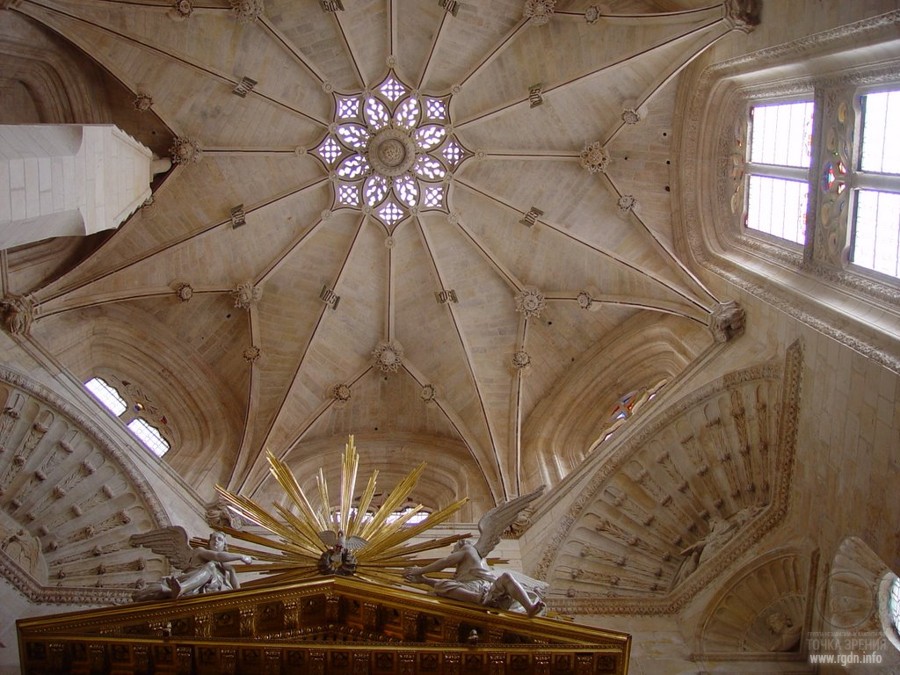
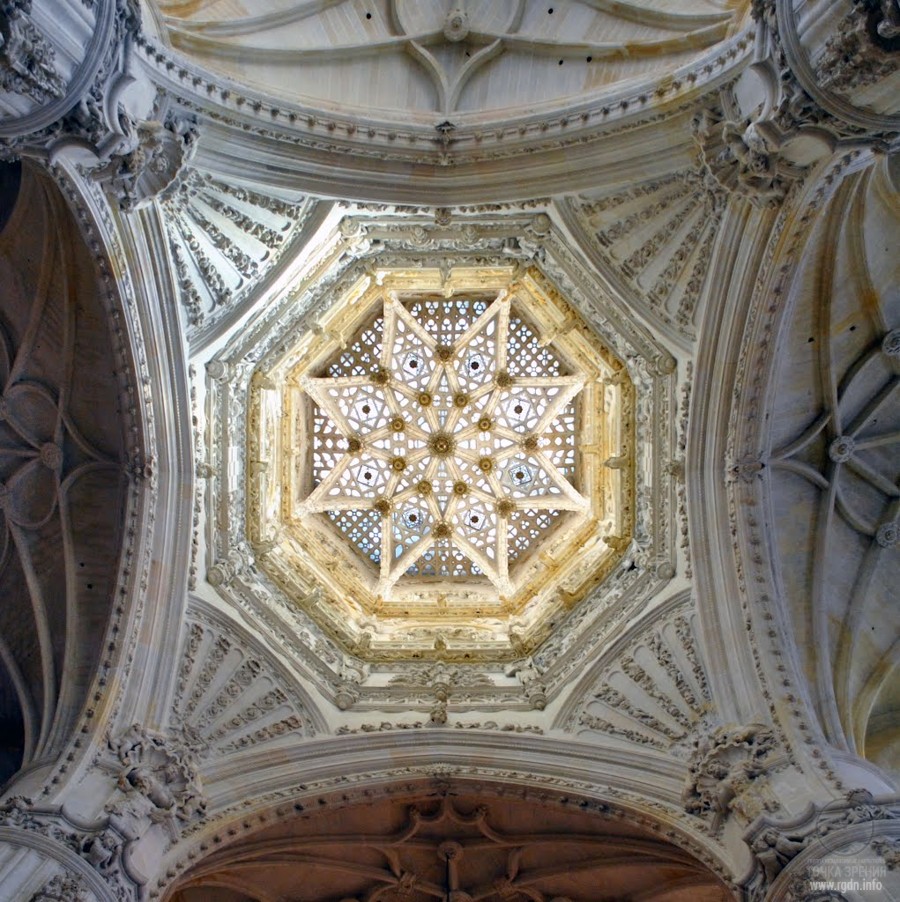
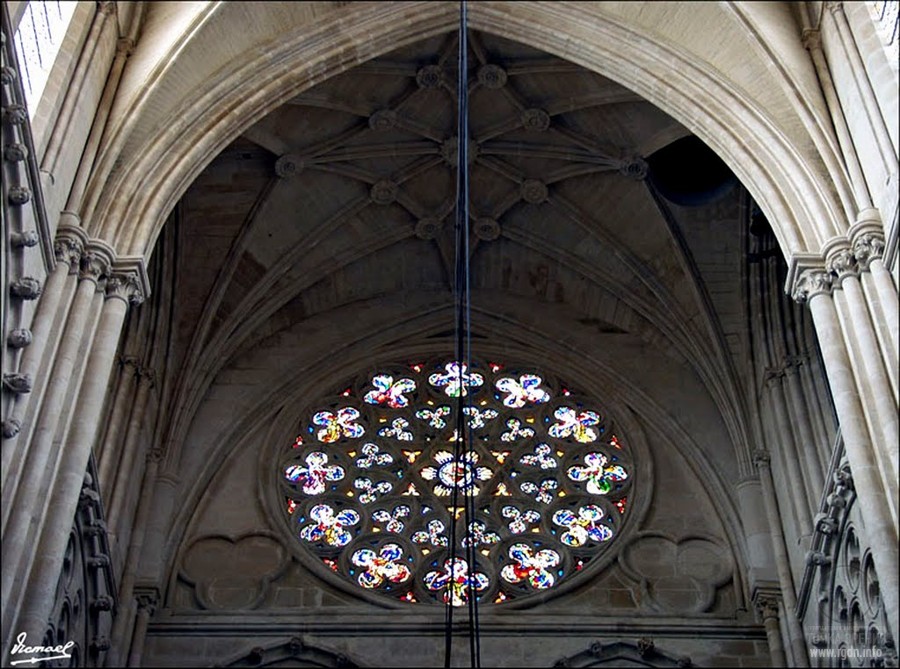
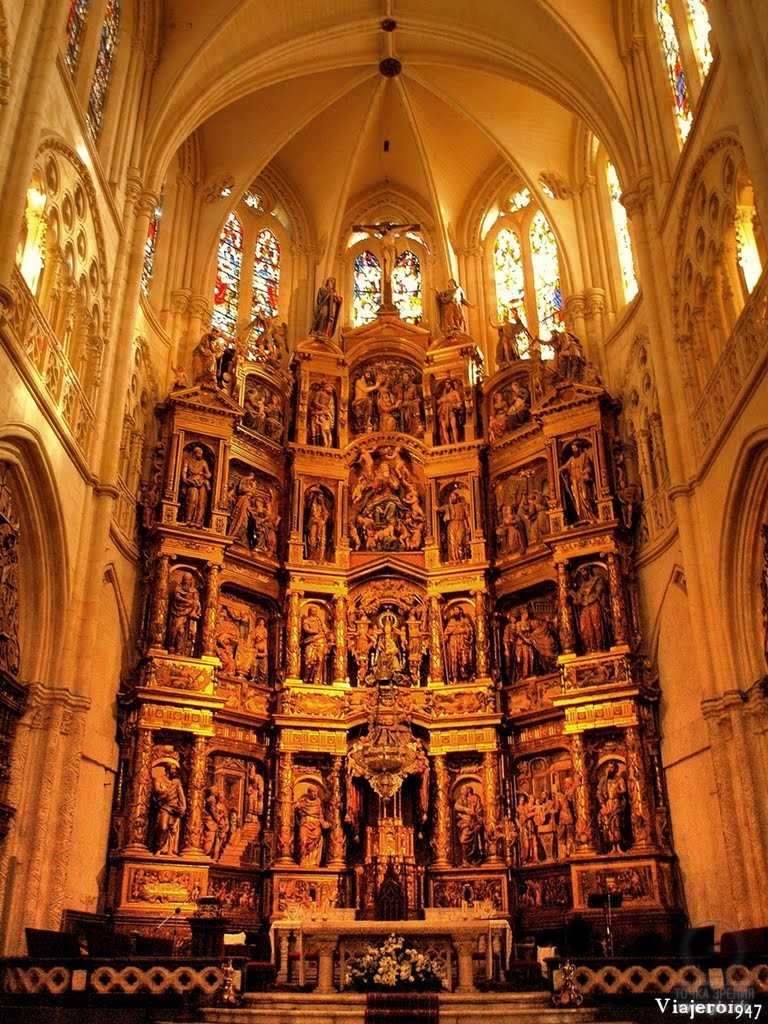
Monasterio de Santa María la Real de las Huelgas
The monastery was founded in 1189 by the king Alfonso VIII of Castile and is considered to be one of the largest throughout Spain. Nowadays the monastery is a part of the national heritage and a pantheon where remains of Castilian monarchs are kept. In the monastery there is a museum of Burgos medieval textiles (el Museo de Telas Medievales de Burgos). Among other things, the famous Mauritanian banner of Almohad Caliphate is kept in the museum, which was seized in the Battle of Las Navas de Tolosa – the turning point in the fight for liberation of Spain from the Caliphate rule.
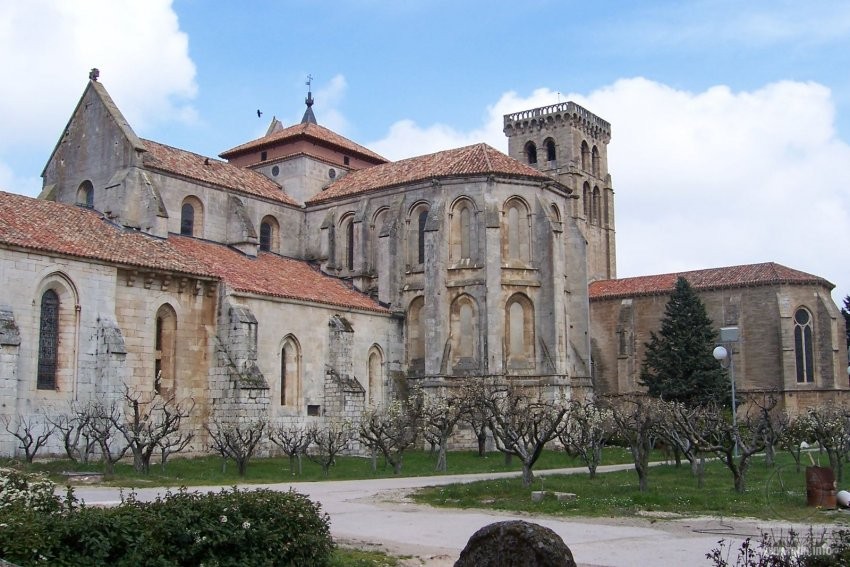
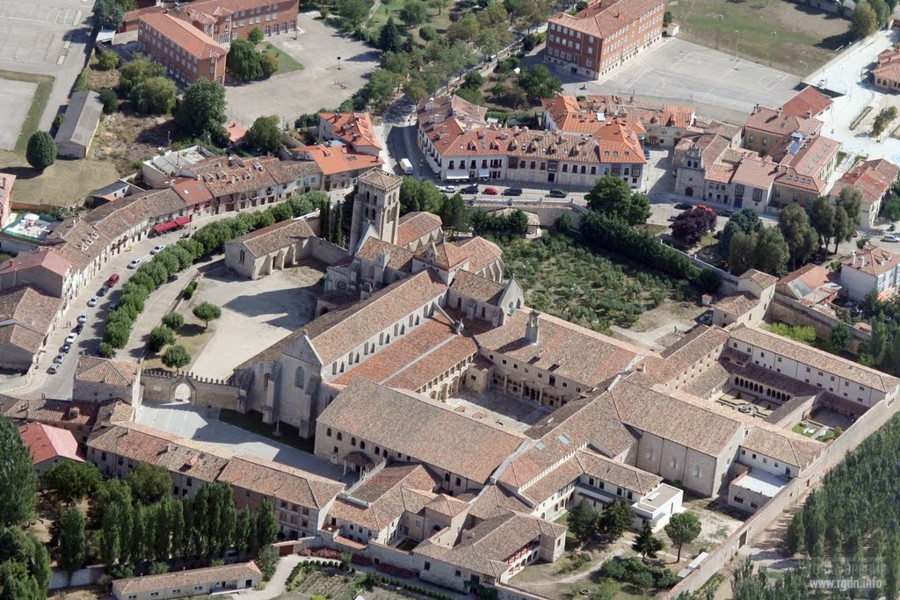
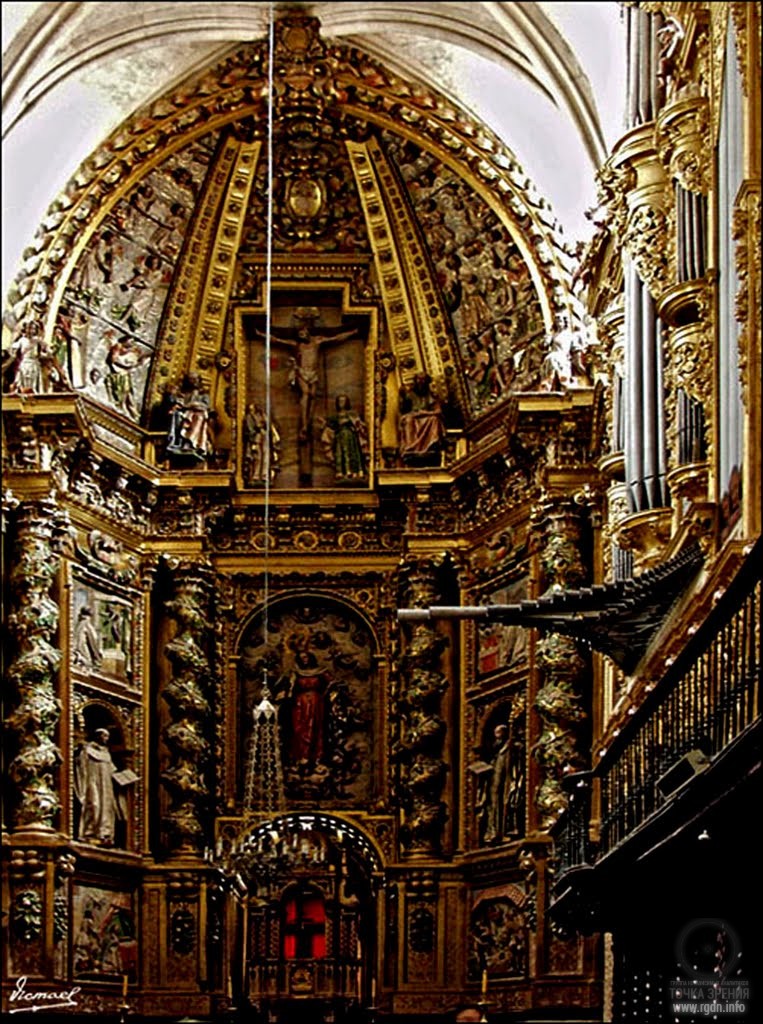
Carrión de los Condes
Carrión de los Condes is a city and municipality in Spain, located in Palencia province which is a part of the autonomous community of Castile and León. The municipality is a part of the county (comarca) Tierra de Campos.
Church of Our Lady of Bethlehem:
 
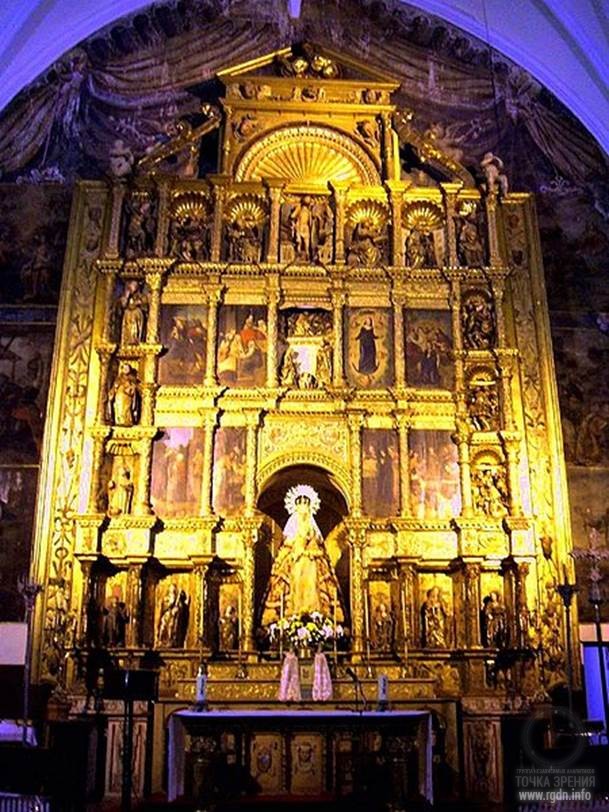
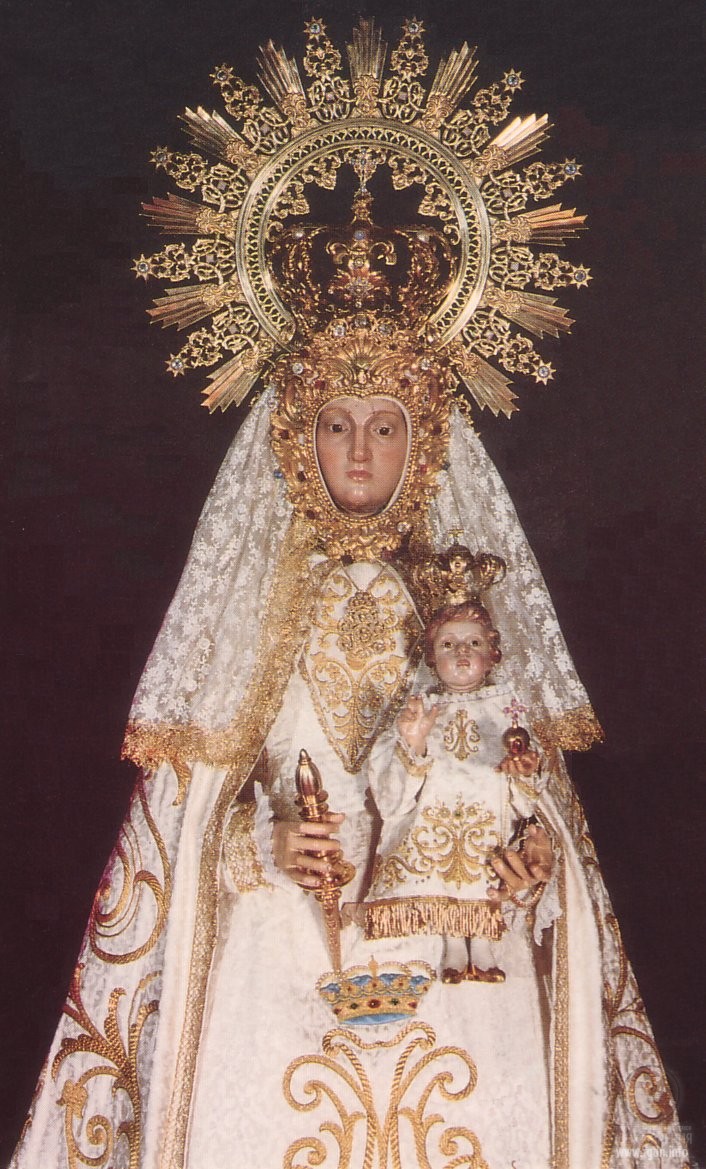
Shells on the altar.
http://webs.ono.com/carrioncondes/belen.htm
https://es.wikipedia.org/wiki/Iglesia_de_Nuestra_Se%C3%B1ora_de_Bel%C3%A9n_%28Carri%C3%B3n_de_los_Condes%29
Processions in honour of Our Lady:
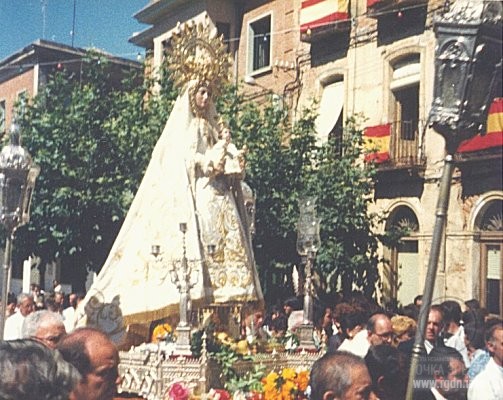 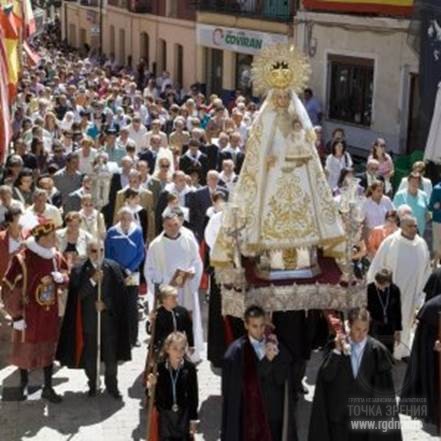
Here’s another description of the city: “20 km far from Frómista on the Way of St. James there is a city of Carrión de los Condes that used to be an important site on the pilgrimage route: over a dozen hospitals and churches for pilgrims were located here. Numerous monuments of religious architecture are still preserved here today. A particularly interesting object is Iglesia de Santa Maria del Camino, a late 11th century church with a Roman frieze depicting the scene of adoration of the Magi and a painting dedicated to the miracle of salvation of 100 Spanish virgins from Moors. Iglesia de Santa Maria del Camino was the first one in the city to greet pilgrims who travelled to the relics of St. James, since the famous French Way ran by it. In the past, another Roman-style church used to be in its place, but it had decayed and required interference. As a result, almost nothing remained of the old building, except the foundation and little fragments of the walls. Thus, a new church appeared instead, the one we can see there today.”
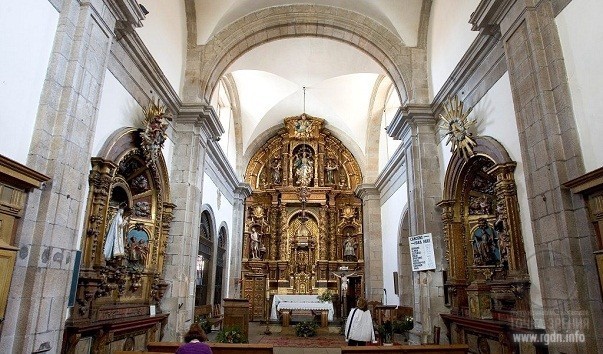
Saint Jean Pied de Port
This is a French Basque city on the Nive River bank. The history of the city is deeply connected with the history of the Way. In the Middle Ages numerous pilgrims from all over Europe met in Saint Jean in order to resist hazards of the Pyrenees together.
Attractions:
- Bishops’ Prison – La Prison dite des Évêques (13th century),
- Église Notre Dame du Bout du Pont (Nuestra Señora de la Puente del Kabesa, 18th century).
- Near the old city exit there is the Gothic-style Église Notre Dame de l'Assomption (Church of the Assumption of Virgin Mary).
- Farther, to the left of the Way, on a steep rocky formation there is a hardly visible little statue of Mary (Virge de Biakarri or d'Orrson).
Roncesvalles
This small village, just like Cebreiro, is one of the oldest places on the pilgrimage route. It is located in the Western Pyrenees, near the Roncesvalles Pass. Here, on 15 August 778 Basques who were allies of Arabs obliterated the rearguard of Charles’s the Great army which was retreating after the unsuccessful siege of Zaragoza and killed commander Roland (The Song of Roland).
Attractions:
- Iglesia de Santa María – St. Mary's Church (13-14th centuries). The main altar with a Gothic figure of Virgin Mary, whom the Spaniards call Our Lady of Roncesvalles.
- La capilla de San Agustín – St. Augustine’s Chapel (17th century), where the tomb of the king Sancho VII is.
- The pilgrim office is located on the ground floor of the old library (15,000 items stored).
- Monastery.
- Gothic church Iglesia de Santiago (13th century) and the pilgrimage chapel Capilla del Espiritu Santo (12th century) built by Charles the Great. Knights who died in the battle of Roncesvalles were buried here, and since the Middle Ages this site has been serving as a pilgrim cemetery.
Navarrete
Navarrete is a small municipality located at the foot of a hill with a population of about 3 thousand people. The main local attraction is the church La Asuncion de Navarrete, the construction of which started in 1553 and was finished in 1645. It’s an enormous church with a shining golden altar.
Iglesia de Santa María de la Asunción, Navarrete
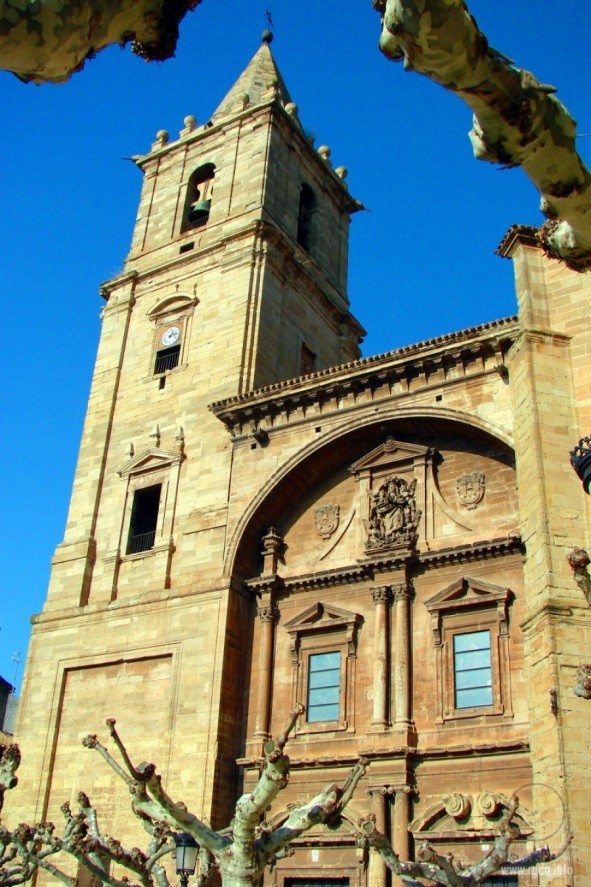
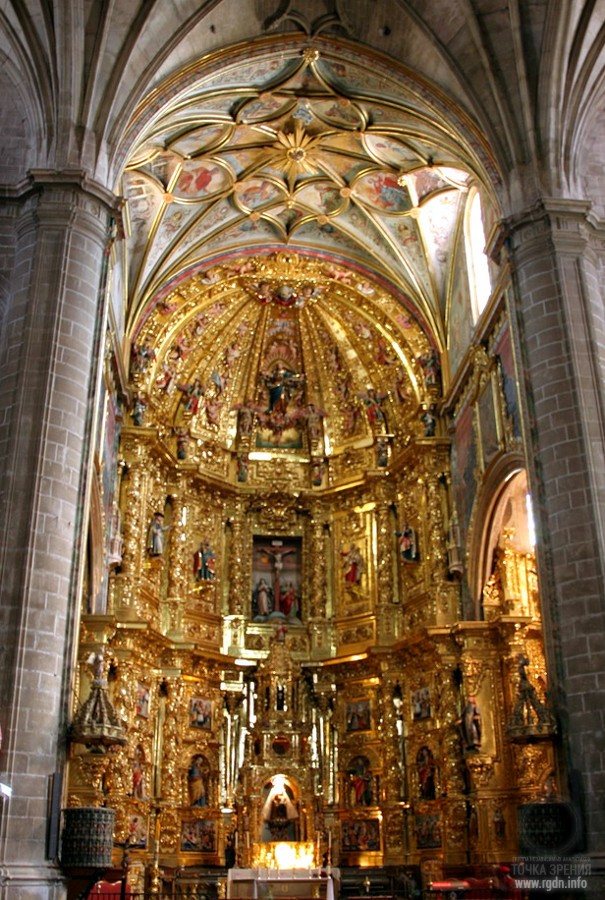
Logroño
It’s the capital of the autonomous community and province of La Rioja. Attractions: Concatedral de Santa Maria de la Redonda (15-18th centuries) with a baroque façade and two towers; Iglesia Imperial de Santa Maria de Palacio built in the 11-12th centuries. Its gabled pyramid-shaped tower is the city symbol called the Agija (spire) by local inhabitants.
Nájera, where the monastery Santa Maria la Real is located, containing tombs of the members of royal families of Navarre, León and Castile.
In the village of Belorado there is a 16th century Church of St. Mary.
In the town of San Juan de Ortega a monastery church of the same name is located, which according to legend was built in the 12th century by St. Juan himself, who helped pilgrims a great deal, erecting churches, roads and bridges for them. Here, there is St. Juan’s fretted Roman sarcophagus and a beautiful Gothic canopy presented to the saint by the queen Isabella I of Castile for the prayers he performed for her to become pregnant. Since that time the church has been a pilgrimage site for childless women. On equinox days a unique phenomenon – the “miracle of light” may be observed in the church: at a certain hour a sunbeam falls on the cap where the Annunciation scene is depicted, illuminating Virgin Mary’s figure.
Boadilla del Camino. Landscapes on this section of the Way are notable for the abundance of peculiar dovecotes of diverse shapes and sizes. In the village itself, pilgrims visit the church of Santa Maria de la Asunción built in the 16th century, with its beautiful 14th century stone font. Nearby, there is a medieval stone bridge (Rollo de Justicia) richly decorated with scallop images and other pilgrim symbols.
Frómista is a city famous for its austere Roman style churches. One of the best churches on the French Way – the Church of San Martin (11th century) has been preserved here. This is the only totally extant Roman church constructed on the pilgrimage route. The second significant local architectural monument is the church of Santa Maria del Castillo, where a multimedia exposition dedicated to the Way of St. James legends and the history of Frómista currently operates.
Santiago de Compostela
The city is the point of destination on the Way of St. James, being on the UNESCO World Heritage List. Among the city buildings the most interesting is the Cathedral of Santiago de Compostela – a remarkable example of Spanish Roman architecture (built around 1080-1211) with its Portico of Glory (Pórtico da Gloria). In the 17-18th centuries the cathedral façade was reconstructed in the baroque style. Two 16th century monasteries are situated behind the cathedral building: San Martin Pinario and San Pelayo.
Cathedral of Santiago de Compostela (St. James Cathedral)
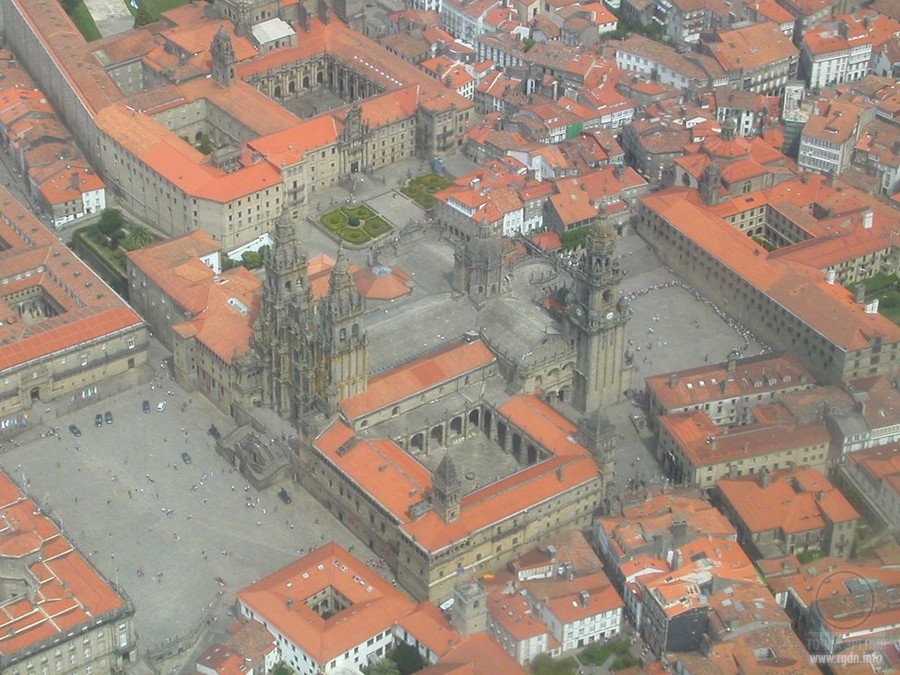
The Cathedral layout
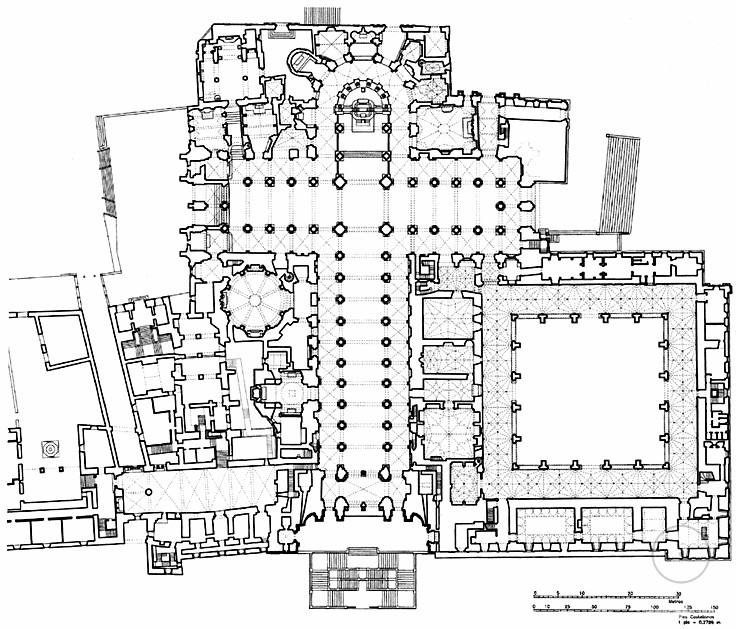
|
|
|
|
|
The Cathedral of Santiago de Compostela has four different façades: central, northern, eastern and southern. The central façade has the same name as the square which it faces – La Plaza del Obradoiro. Constructed in the baroque style in the 18th century by architect Fernando de Casas Novoa, it embodies features of various epochs. The northern façade of the cathedral – Azabacheria – was built in the second half of the 18th century. Its design distinctly reflects the transition from the baroque age to neoclassicism. The eastern façade is called Quintana, also by the name of the square that it faces. It was finished in the second half of the 17th century in the baroque style, though, from the aesthetics perspective, it has suffered from permanent reconstructions of the 12-17th centuries. The southern façade called Platerias was built in 1075 in the Roman style and is the oldest of the Cathedral of Santiago de Compostela façades. It represents a sheltered entrance with finely executed Roman arcatures.
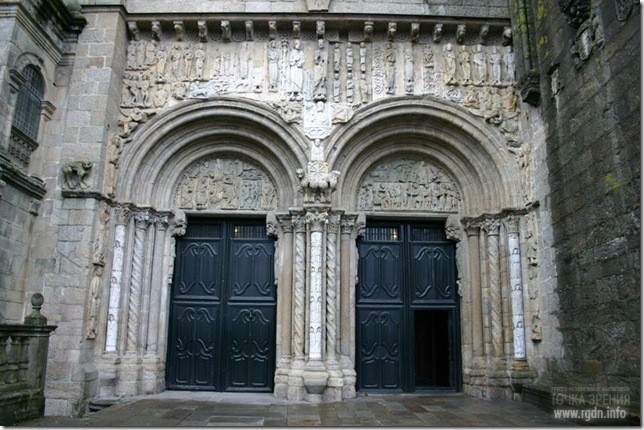
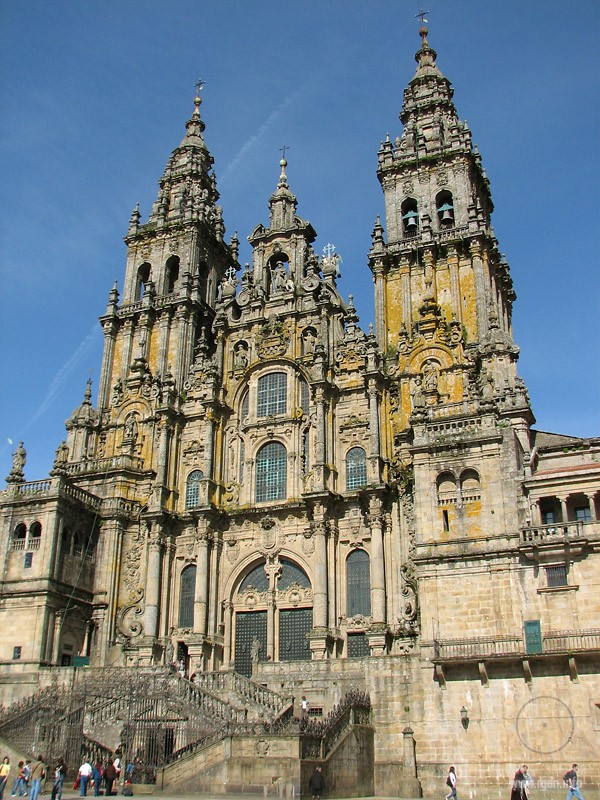
The hallmark of the Cathedral of Santiago de Compostelais the 18th century baroque façade attached to the Roman church.
One of the cathedral major attractions is the world’s largest censer “botafumeiro” (“emitting fume”) of a man’s height, suspended from the ceiling. It has been used in the Cathedral of Santiago de Compostela for already 700 years! The censer has 80 kg in weight and is driven by eight priests who wear red clothes and swing it, the swinging speed reaching 60 km per hour. 40 kg of coal and incense are needed to feel the censer!
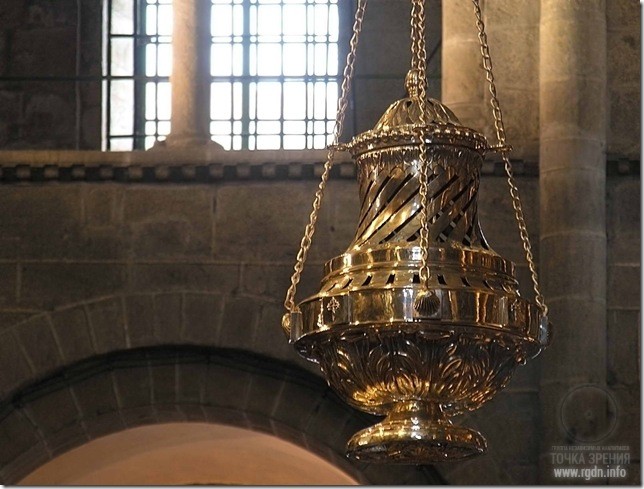

The Cathedral exterior

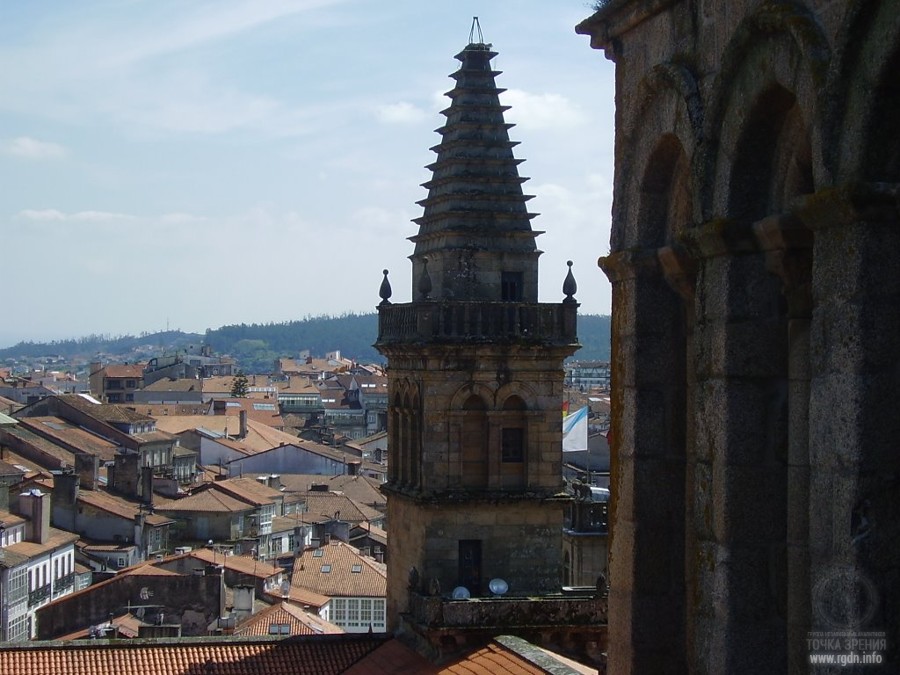
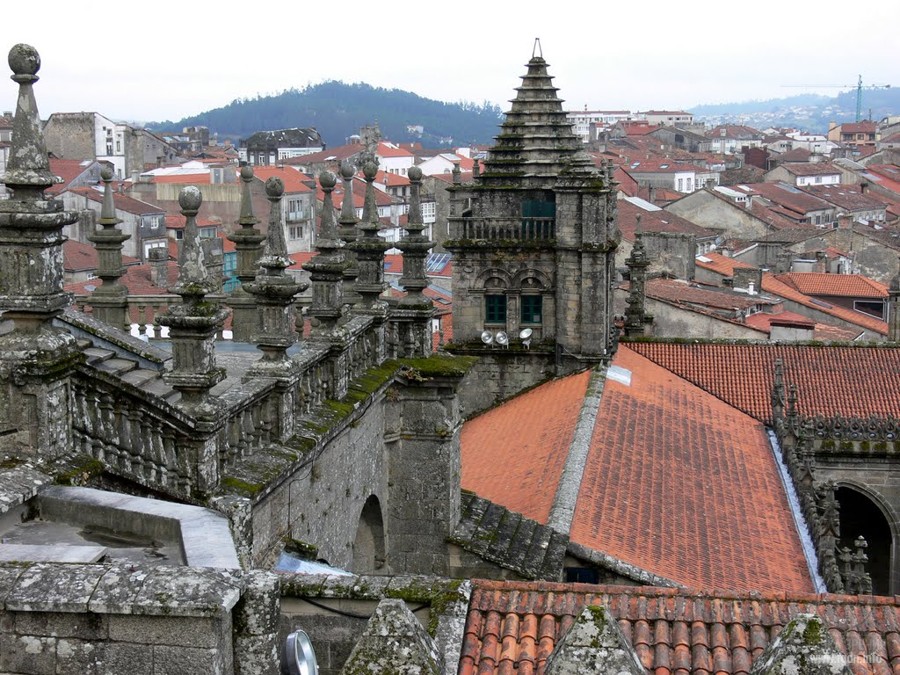
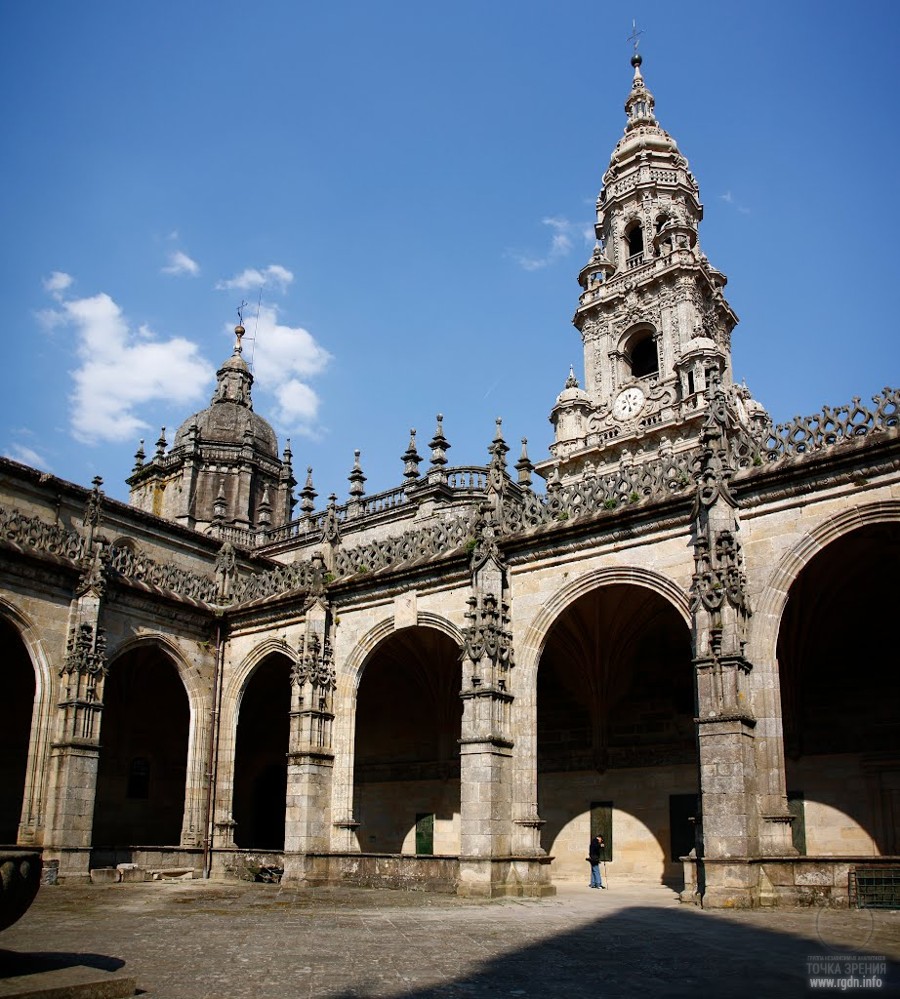
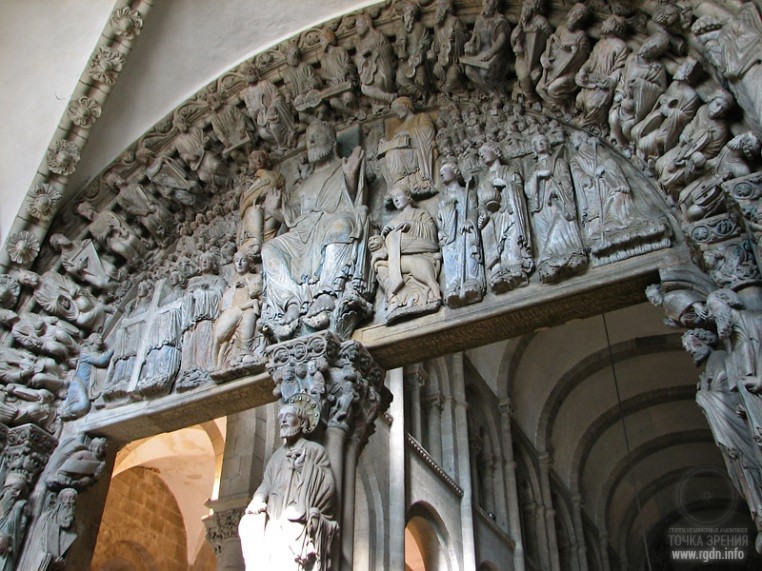
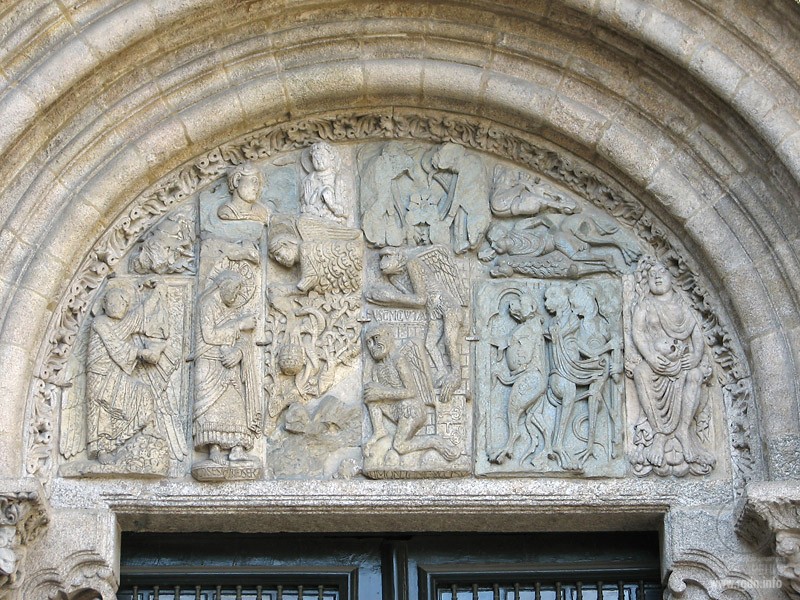
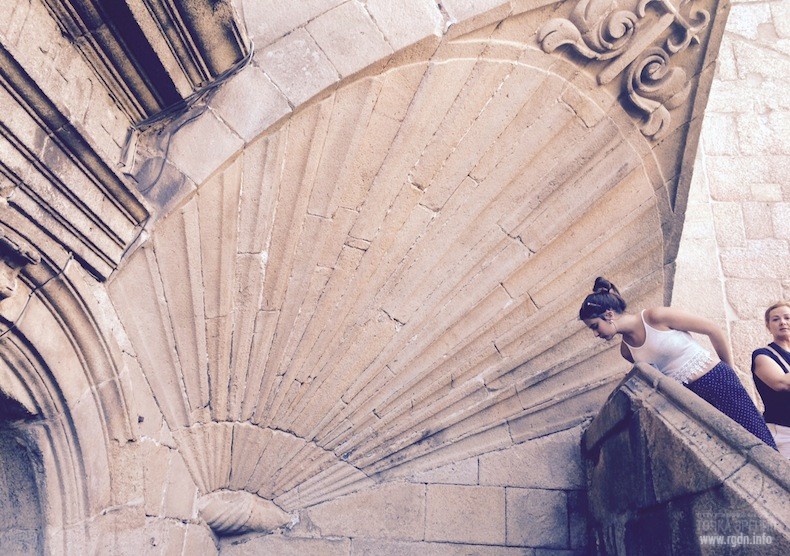
The Cathedral interior
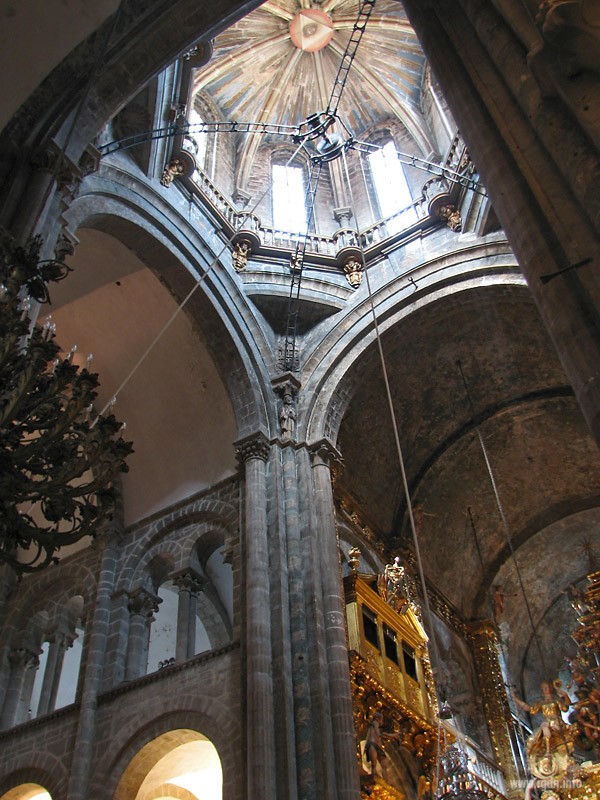
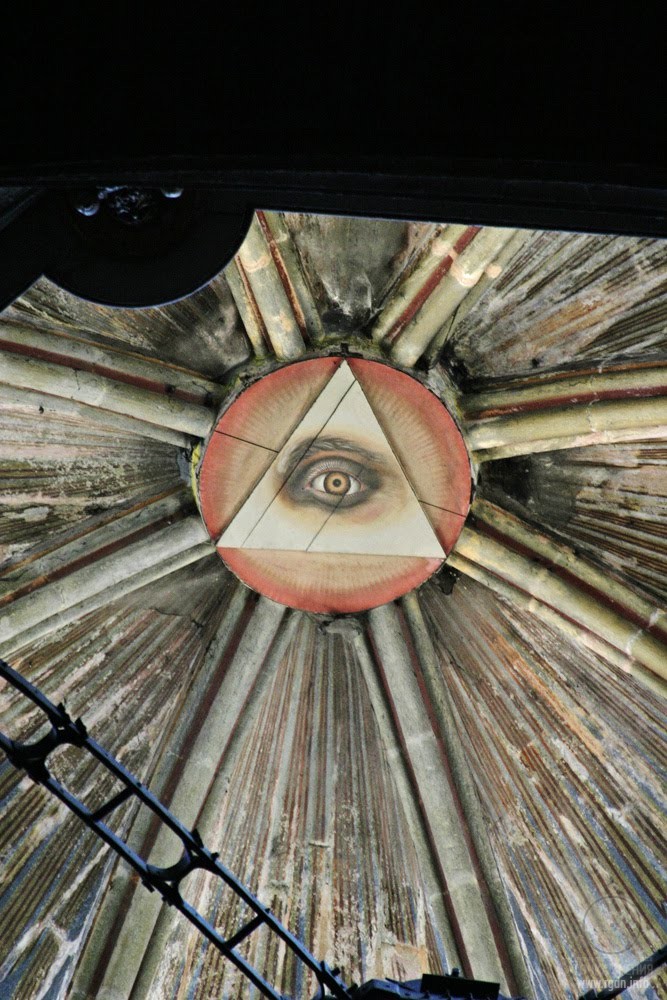
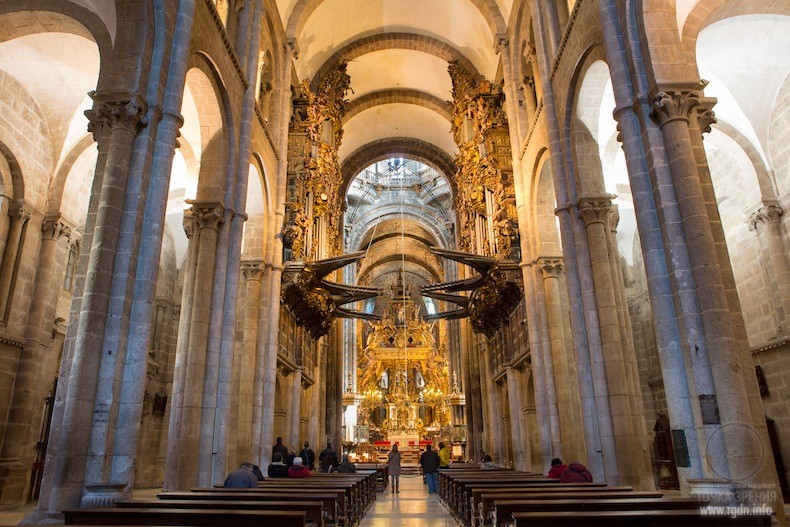
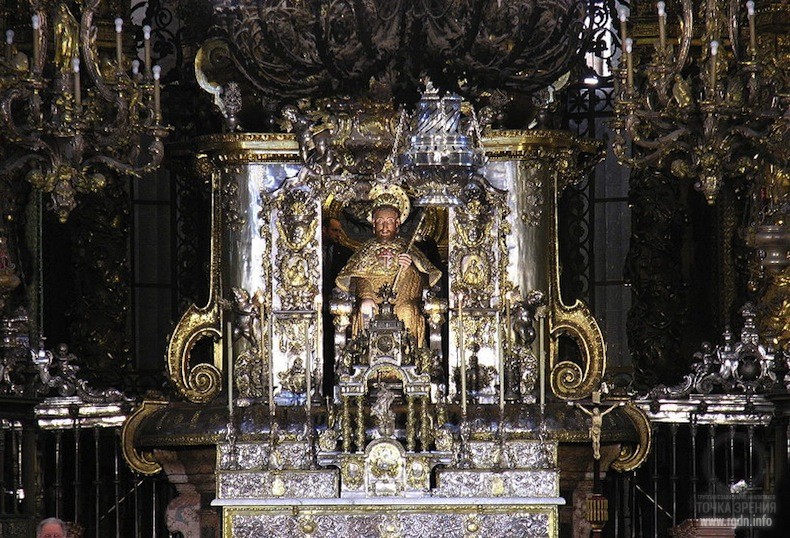
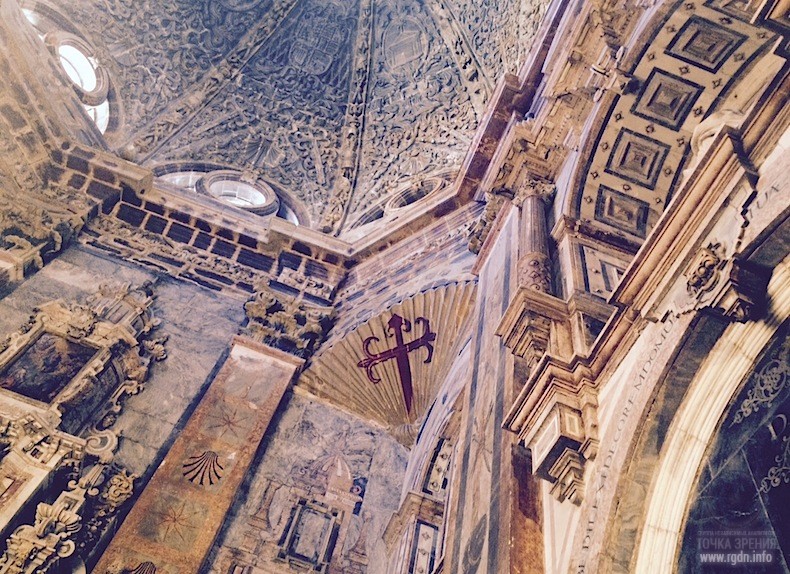

St. James’s shrine
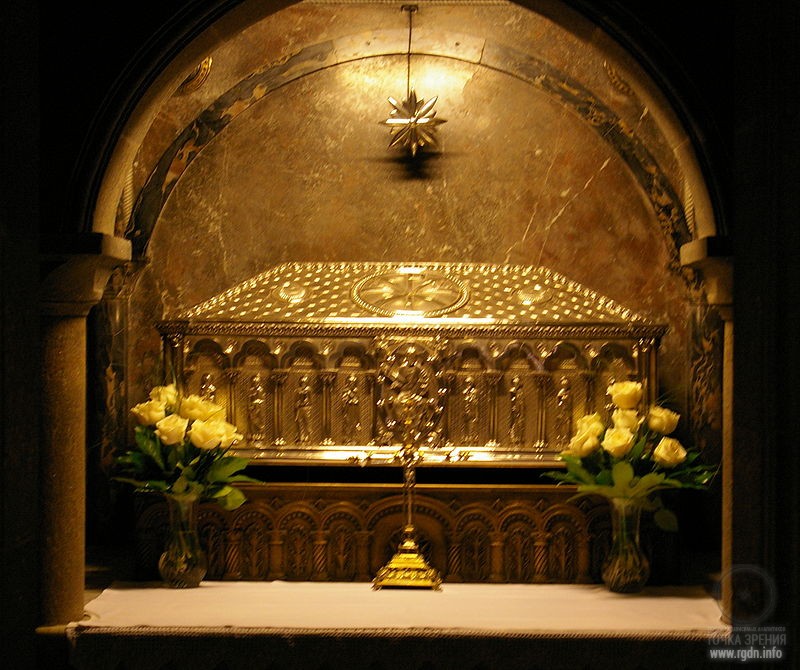
A marvellous story of the relics
The saint’s relics are kept in a silver reliquary in the undercroft extant from the church of the times of Alfonso the Great. In 1589 the relics were concealed from the English Counter Armada so carefully that they failed to find them afterwards. The relics were rediscovered only in January 1879, and five years later Pope Leo XIII confirmed their authenticity. At that, in 1895 the Codex Calixtinus manuscript found in the cathedral was published. Its authorship is ascribed to Pope Calixtus II, and it contains valuable information about the cathedral construction.
_______________________________________________________________________________________________
ANALYSIS OF THE LEGEND
At that, the official information on the subject is over, and so I’ll switch to analysis. First of all, I will look at the legend from the point of view of a detached observer who neither has heard nor knows anything about symbolism. So, when I follow the Way, I see nearly in every point on the route how Virgin Mary is worshiped: there are churches, chapels and bridges named after her, and festive processions in her honour are arranged. However, when I arrive at the destination site, I see St. James’s figure there. Even from a detached observer’s perspective this looks rather strange, not to mention the enigmatic legends where only miracles are described. The boat with the relics was miraculously cast up on the Spanish shore, the star miraculously pointed at the relics, and thus they were found, the relics were miraculously found after their three-hundred-year absence!!! Well, if Pope Leo XIII himself confirmed this… who could doubt his words?
Yet, it’s quite notable there are clever people who are truly interested and endeavour to get at the roots of things, and they have already discovered that Virgin Mary is associated with a shell. Orthodoxy has helped: CANON OF GRATITUDE WITH AKATHIST TO THE MOST HOLY MOTHER OF GOD.
|
|
And now: the Extensive sanctuary of the Word, / rejoice, the Purest, / shell that has produced Divine Pearls; / rejoice, the All-Marvellous, reconciliation with God / of everyone who always calls You, Our Lady, / the blessed.
The Shell that has produced Divine Pearls
|

To tell the truth, all this is associated with Our Lady’s escape together with little Christ from the king Herod. She supposedly escaped to Spain, and this is the origin of the shell image and the reverence of Virgin Mary in those places.
Now I’ll switch to information from A. Novykh’s books.
First of all, let me give a couple of quotes for those who will possibly read this article, but are unfamiliar with the author’s literary works.
Not everything what looks black in the human world is black. And not everything what seems to be white is white. Perception of colours depends on one’s inner essence.
Aspirations for knowing the truth are surely praiseworthy. But remember, when you get more knowledge, you get more sorrow.”
So, who was Saint James, son of Zebedee? According to the official interpretation which I have referred to in the beginning, he was a “special” close disciple of Jesus, along with his brother John and Peter.
A quote from Sensei-IV book:
“John was a younger son of Galilean fisherman Zebedee, a favourite of his mother Salome, the daughter of that very Joseph for whom Jesus’ mother Mary worked for some time…”
“Daughter of Joseph?” Nikolai Andreevich asked, being surprised. “That is, Salome was the sister of Jacob and Judah. Does this mean that John… all of them belonged to the same family?”
“Yes. John was just one of close relatives of Joseph’s family who first tormented Mary in every way possible, using her as a slave, then flung mud at Jesus, and later on earned big money on His glory.”
Elder brother… younger brother… one family… these are the so-called “close, special disciples”.
Let’s move to symbols. AllatRa by Anastasia Novykh:
Anastasia: By the way, going back to the conversation about the peculiarities of the architecture of the temples among the peoples of the world, where the main symbols, including the pearl, were used… Just like Christian churches have the building altar part shaped as a semi-circular niche oriented to the East, so do Muslim mosques have a special semicircle niche – “mihrab” (the Arabic word “michr’ab” means the “direction of the prayer”). It is oriented towards the location of Mecca – the sacred city for the Muslims (located on the Arabian Peninsula in southwest Asia), where one of the main Muslim shines is located, a structure in the form of a cube – Kaaba. Thus, this niche is decorated with ornamental carving, painting and encrustation. Its internal dome is often designed in the form of a shell – the symbol of storage of the precious spiritual pearl.
Rigden: That is right. Such design is understandable because Muslims have a lot of legends about the pearl, and they single it out into the category of special symbols. For example, by saying of the Prophet Muhammad, the world was created from the White Pearl. According to Muslim beliefs, the Almighty created the White Pearl, the thickness of which was seven skies and seven lands taken together. When God called the Pearl to Him, it trembled from His call and turned into streaming Water. Of all the creations that at some time of day or night, one way or another, interrupt their glorification to the Almighty, it alone, already being Water, not for a moment ceased to glorify the Creator, permanently waving and foaming. That is why God gave it superiority over others, making it the source and the beginning of life of all living beings. So, all the living beings were made of Water. And in order to carry this precious Water, the Almighty created Wind (Air), having endowed it with an “uncountable multitude” of wings.
That is why, as a rule, this sacred niche is filled with many symbols. It was associated with the Blessed Virgin, the pure Soul. Earlier inside the mihrab a burning lamp was hung, because the divine presence in the world or in man was likened to the light of a lamp. The lamp is in the glass, and the glass is like a pearl star – a symbol of the “Light on the light”.
Anastasia: Regarding the symbols, it’s also quite interesting to look at the composition of the prayer mat (namazlik) among the Turkic-speaking nations practising Islam. In its carpet nominally ornamental picture, it usually imitates the mihrab of one or another region.
 
Figure 78. Symbolic images in Islam:
1) a shell-shaped arch of the mihrab niche (Big column mosque-cathedral Mezquita, which is considered to be one of the largest in the world; year 785 – the early 11th century; Cordoba, Spain);
2) a prayer mat (Turkish namazlik); art of the Turkic-speaking nations practising Islam
Rigden: By the way, there are mainly all the same symbols and signs that belong to the cultures and religions of many other peoples: octagons, hexagons, rhombuses, squares, diagonal crosses and so on… Generally speaking, a shell with a pearl in the ancient times was a symbol of the Soul, of the creating divine feminine principle. It was an attribute of many female deities and their names, a symbol of the water sacred element. As I have mentioned before, the latter meant a habitat that was different from the earthly one and entirely different for the human understanding. However every living thing was derived from it, was dependent on it, and needed it. The Bible mentions the words of Jesus Christ, when he explains what the Kingdom of Heaven is like (Mathew, chapter 13, verses 45-46): “Again, the Kingdom of Heaven is like a merchant looking for fine pearls. When he found one of great value, he went away and sold everything he had and bought it.”
***
For example, the name Margarita (a pearl) originated from epithets of the goddess Aphrodite, who, according to ancient Greek mythology, was born as a result of virginal conception and arose from the sea foam in a shell, like a shining pearl. The name Marina (“marine”) is derived from epithets “shining” and the “Mother of pearl” of the ancient Roman goddess Venus (the Latin word “veneris” meaning “love”), who was identified with Aphrodite. One of her symbols was a female dove. That is why in early Christian art, which originated in the Roman Empire, there were images of Virgin Mary with a shell above her head as a symbol of the one who brought “Divine Pearls”. It should be noted that the name Maria in the Roman Empire was associated with a concept which was traditional for the peoples living there – of the goddess of Love – “the glowing one”, “the Mother of pearl”! But not “sad”, “rejected” and certainly not “bitterness” as her name was later on presented by the Jewish priests for the public.
See details in the AllatRa book online version: http://allatra.us/allatra-online, pages 527-532.
Besides the shell symbol, an eight-pointed star is found in the Cathedral of Santiago de Compostela and other churches on the Way. The meaning of this symbol is described in the first article of the series: “An eight-pointed star is a symbol of the rhombus (a cube set on one of its vertices as a symbol of human transformation into a spiritual being and of entry into the spiritual world).”
Rigden: Regarding the information recorded in the symbols of the icon Christ in Majesty (Spas v Silah), in Rus this knowledge was later disseminated also through the image of the icon of Our Lady of the Burning Bush (Neopalimaya Kupina). Thus, the symbolic and allegorical composition of this icon in its main geometrical details practically repeats Christ in Majesty: a red square (with four evangelists in zoomorphic, apocalyptic images – a human, a lion, a calf, and an eagle), a diagonal cross, a hidden oval, a rhombus (in which the image of the Mother of God (Our Lady) is inscribed, 6 angels in the rhombus). In general, everything is as it should be. Only the geometrical elements are named differently in descriptions, for example, as two four-pointed stars put over each other (a total of eight vertices) or as an eight-pointed star with a truncated lower beam! And the rhombus is, as a rule, green or blue (navy blue) in colour, while the square under it is red, as it should be. In the centre of the composition is the Mother of God (Our Lady), who is holding Baby Christ in her left hand, while in her right hand there is a ladder (sometimes a ladder in such icons touches a shoulder of the Mother of God, and sometimes instead of a ladder a Gate and a rod are drawn as a symbol of the Saviour). All this symbolizes that it is the Mother of God who spiritually elevates humanity “from Earth to Heaven.” Among the images in this icon, there is Archangel Gabriel with a symbol of glad tidings – a branch of lily.
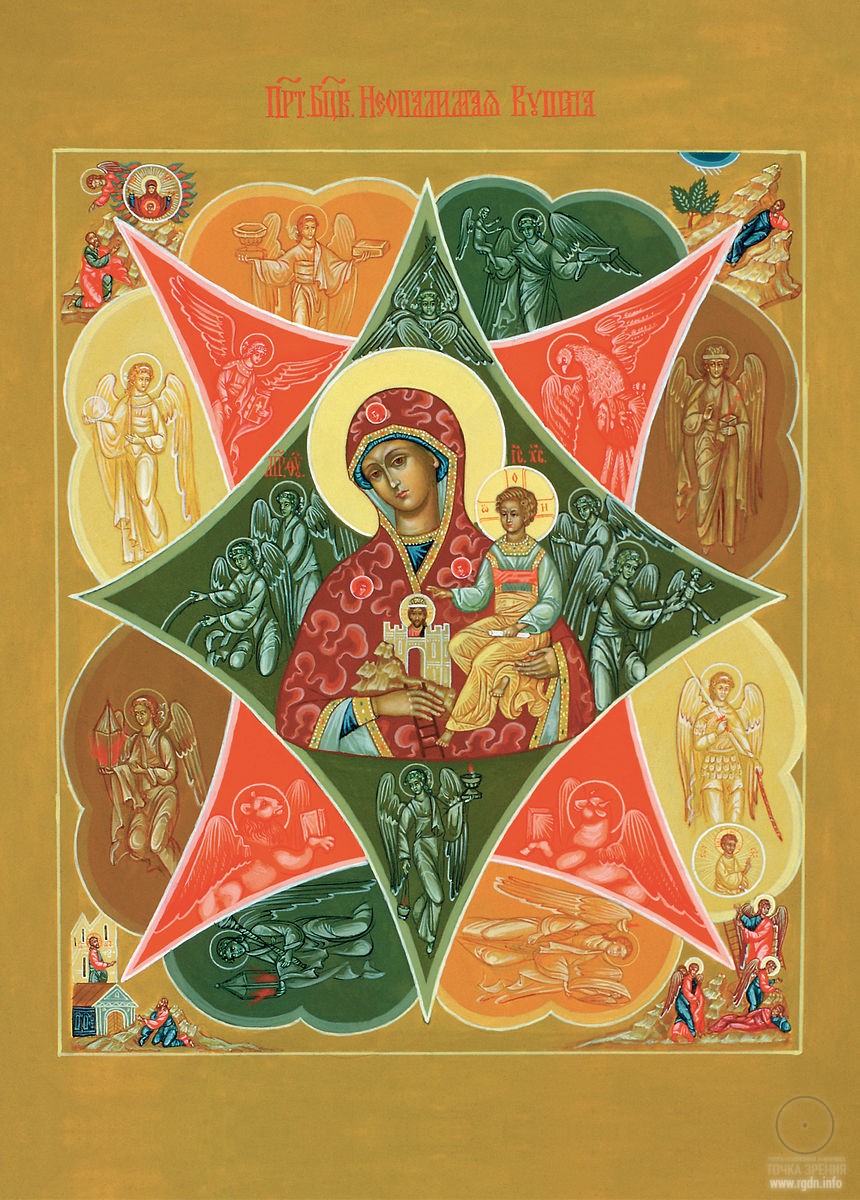
It is no coincidence that Our Lady of the Burning Bush (Neopalimaya Kupina) is associated with the symbol of the immaculate conception of God’s Mother from the Holy Spirit. This is exactly a symbol of what I told you before. God’s Mother is a Conductor of the power of God for every person following the spiritual path; she is the power of God’s Love, with whose help the human Soul is liberated from earthly reincarnations. (AllatRa online version, pages 611-614)
As we see, symbols of a shell and an eight-pointed star are the symbols of Mary, the one who has brought “Divine Pearls”.
Rigden: …and the real spiritual support is provided to people for salvation of their souls.
Now you see the whole point about St. James. It’s too coarse substitution to remain unnoticed, and, as I have written above, even those who are yet unfamiliar with the primordial knowledge do notice the substitution and see Mary instead of James.
It is noteworthy that the Cathedral of Santiago de Compostela was constructed approximately at the same time as St. Sophia’s Cathedral in Kiev and, just like St. Sophia’s Cathedral, in the 17-18th centuries was reconstructed or “finished” (it’s hard to say for sure now) in the baroque style.
At this point the article could have been completed, for it seems everything is clear: Mary was replaced by James with total awareness, and Archons were certainly involved in the substitution, but eventually people forgot the origin, and so now they go cap in hand to James, son of Zebedee. However, this is not all, because Santiago de Compostela is actually not the final point on the route.
“For some people Santiago de Compostela is not the pilgrimage destination at all. They go farther – to Cape Finisterre on the Atlantic coast.
Another holy site is located there – Señora da Barca where, according to legend, Virgin Mary moored on a boat to support Apostle James in his feat. Historians believe heathens considered Finisterre to be the end of the earth and the world. By tradition, pilgrims who have reached this place burn their clothes and footwear on the seashore.”
Muxía, La Coruña, Spain
Muxía is a coastal town and municipality in Spain, located in La Coruña province of the autonomous community of Galicia. The municipality is a part of Finisterre conarca. It occupies an area of 122.10 km² and has a population of 5,423 people. And here it is – Señora da Barca (the Virxe da Barca sanctuary): https://en.wikipedia.org/wiki/Virxe_da_Barca_sanctuary
Santuario de la Virgen de la Barca
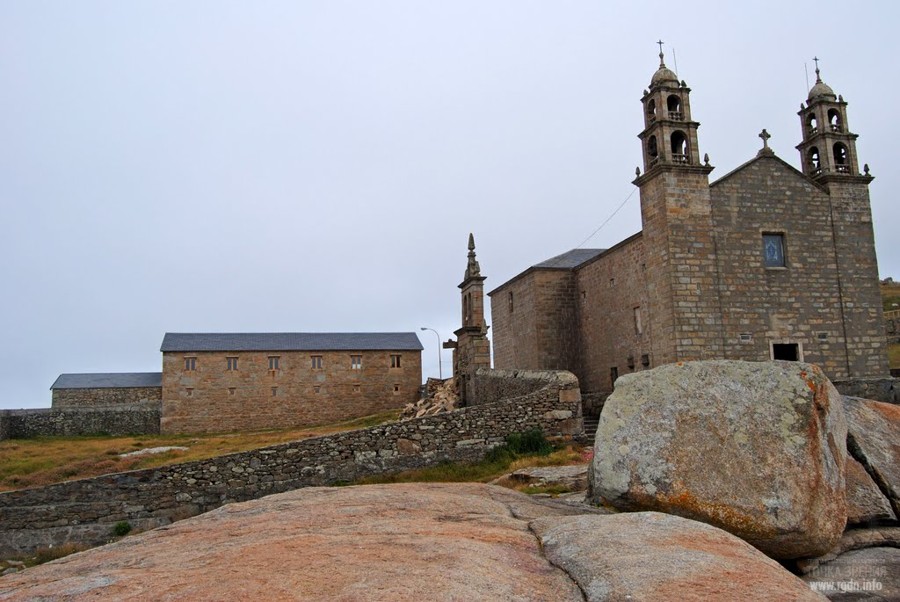 
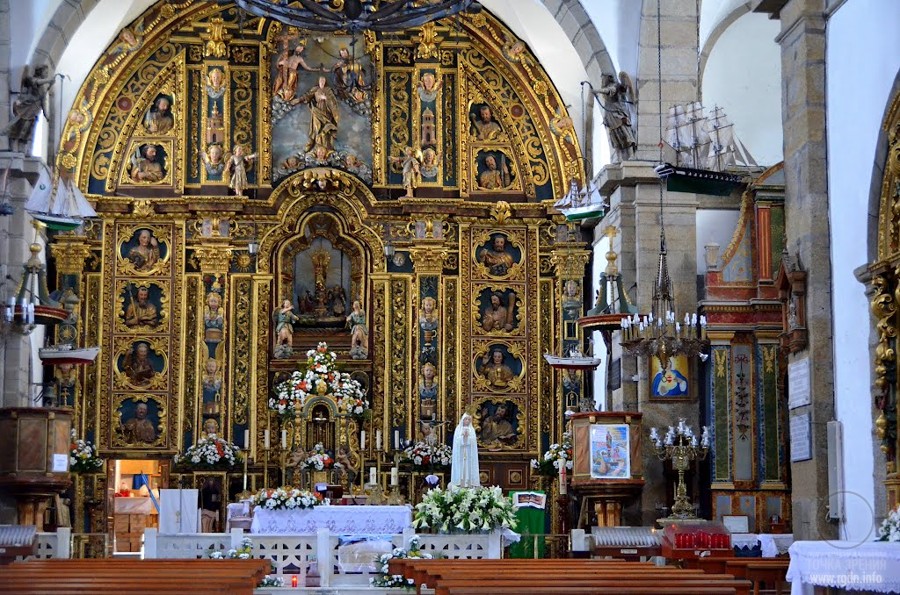
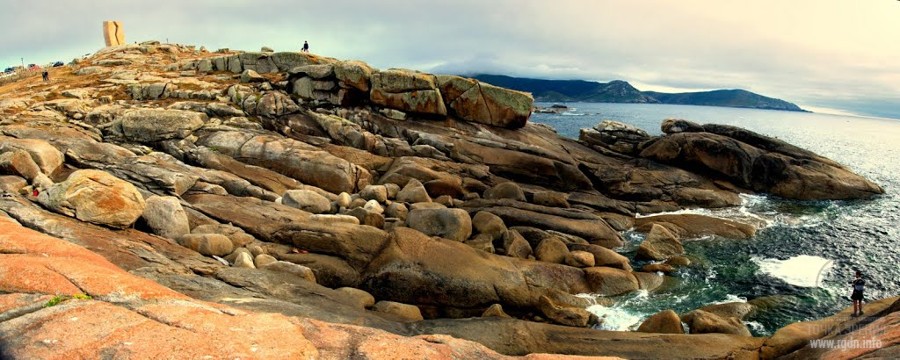
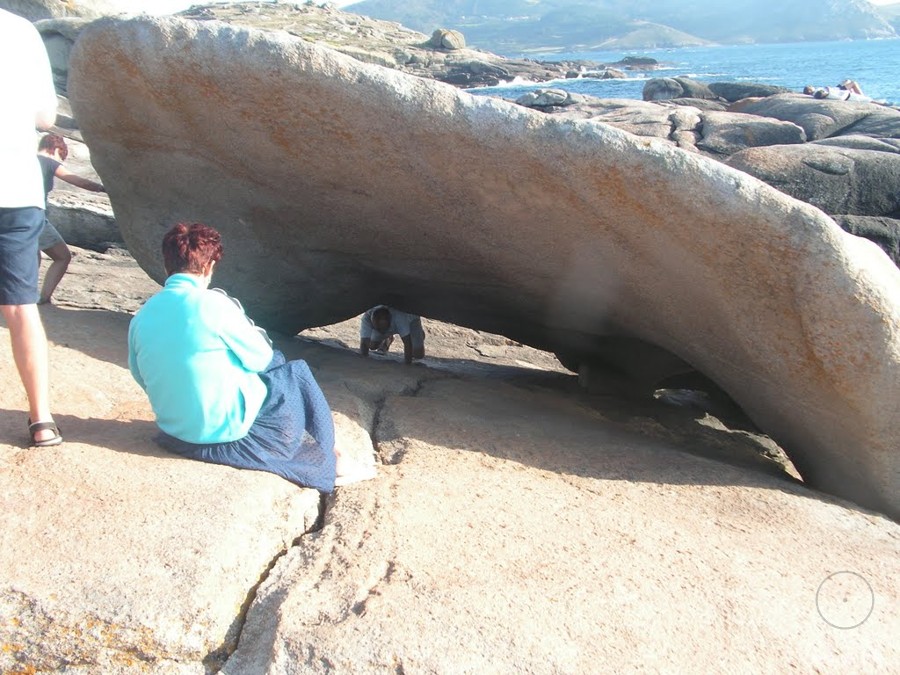
The church was erected in the place of an ancient Celtic sanctuary. Celtic stones lying near the church are called the petrified remains of Virgin Mary’s boat.
Now I shall try to analyse the point relating to orientation on the route. According to legend, pilgrims oriented themselves by the Milky Way. Let me assume though that ancient pilgrims oriented themselves not by the Milky Way, but rather by the star Sirius.
About the Milky Way: http://www.krugosvet.ru/node/36982
In the northern hemisphere the best time to observe the Milky Way is around midnight in July, 10 p.m. in August or 8 p.m. in September, when the Northern Cross of the Cygnus constellation is close to zenith. Following the glimmering belt of the Milky Way with our eye to the north or northeast, we pass the Cassiopeia constellation (W-shaped) and move towards the bright Capella star. Farther from Capella we can see how the narrower and less bright section of the Milky Way passes slightly to the east of Orion’s Belt and inclines towards the horizon not far from Sirius – the brightest star in the sky.
Pilgrims looked at the horizon line and saw one of the brightest stars there – the Sirius star; being guided by it, they followed the needed direction. (This is my assumption only). At that, the Sirius star is associated with another woman who, just like Mary who brought “Divine Pearls”, rendered spiritual help to people in her time. This is Isis.
I will repeat one more interesting point: “Historians believe heathens considered Finisterre to be the end of the earth and the world. By tradition, pilgrims who have reached this place burn their clothes and footwear on the seashore.”
That is, ancient pilgrims, being guided by the star, walked to the place which was considered the world’s end and, having arrived there, burned their clothes and footwear. Certainly, this is rites and shaman dances, but any rites and rituals have some meaning behind them.
In total silence I have reread the preface to the AllatRa book again. It may be considered a separate work of literature with a certain peculiarity, and it’s not subject to any analysis which would be useless. It simply helps to answer the question that is complicated for many, though it is very simple as such: “WHO AM I?”
“But it’s so hard!” cry many people. No, it is not. So many times I’ve put the clothes on. I roamed an endless road with just a staff, feeding the flesh with only what I found. I was a king; for long I ruled over the countless peoples. And every time the clothing would be tight, the clothes would hamper me and hinder me from living. They’d shake with fear and get sick, and, like all others’ at first they’d wish for much until I’d tame them. That wild beast of which the dress is woven fears just its master, just the Soul. But many fear the Soul more than the beast; the Soul that hinders their lives just like the clothing hinders mine. I cannot understand such people. Wasting the whole Eternity on only just one moment? What is the point here? To suffer in the arms of the beast’s skin, to serve the pants decaying day by day. Is life in this? But life is infinite! It has no suffering; it does not tear, for it’s impossible to wear out the Soul. The clothing has no Home; there’s just a closet where it is kept for only a short while. Only the Soul has a true Home. And it’s the Soul that, yearning for Eternity, begets this sense of Home, for which man searches his entire life.” Rigden Djappo
From a symbolism perspective, the Way of St. James is the way of Spirit, the human spiritual path on which every person can step and which everyone can cover, somebody faster and somebody slower. If a person has passed the way till its end, at the end he or she stops living by material values, and matter no longer plays a dominate role in his or her life – he / she “burns the clothes” and lives in Spirit. At that, nowadays every person is supported on this way by Mary the Star!
THANK YOU, MARY!

|
|
|
 Primer
Primer
 Anterior
2 a 6 de 36
Siguiente
Anterior
2 a 6 de 36
Siguiente Último
Último
|
|
| |
|
|
©2024 - Gabitos - Todos los derechos reservados | |
|
|

